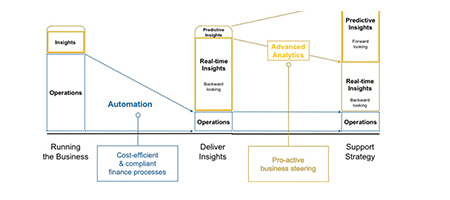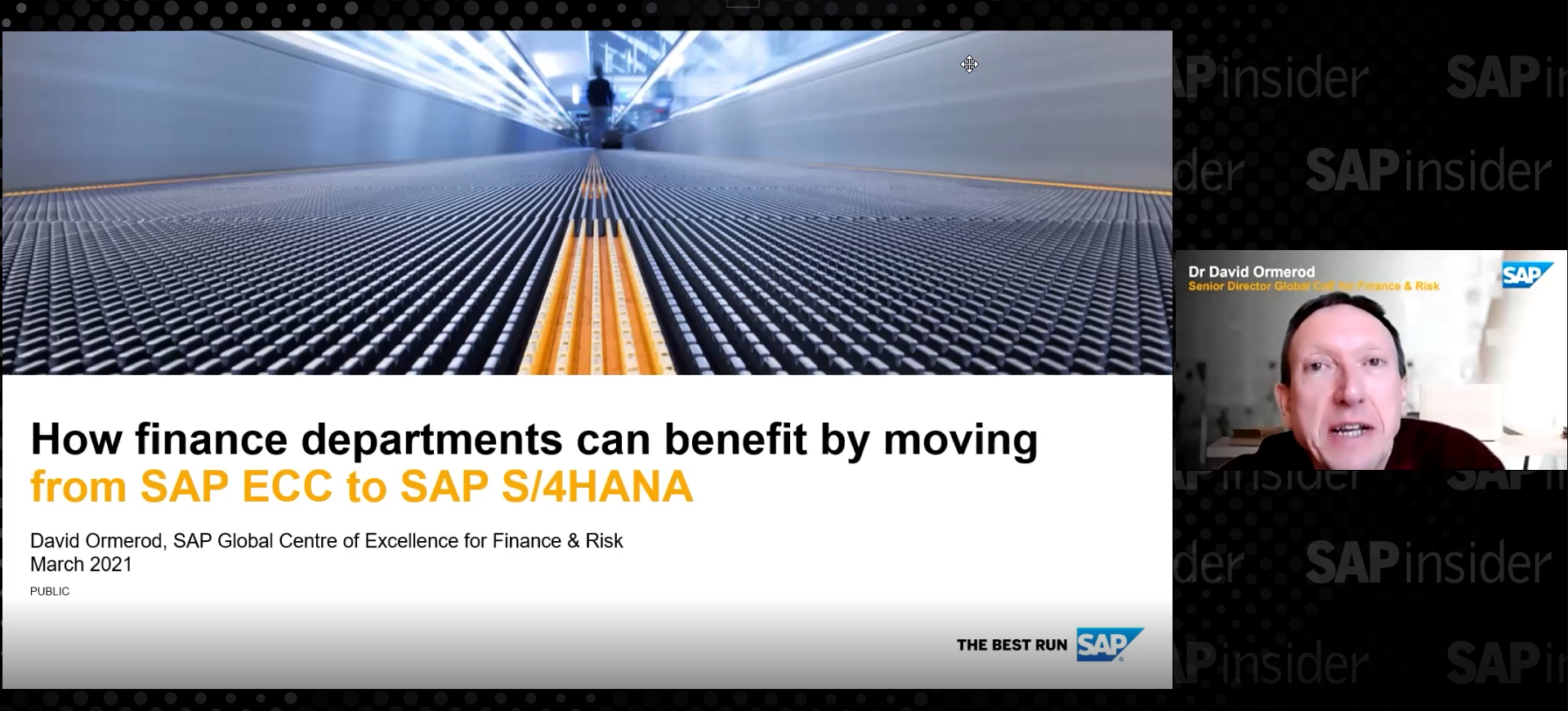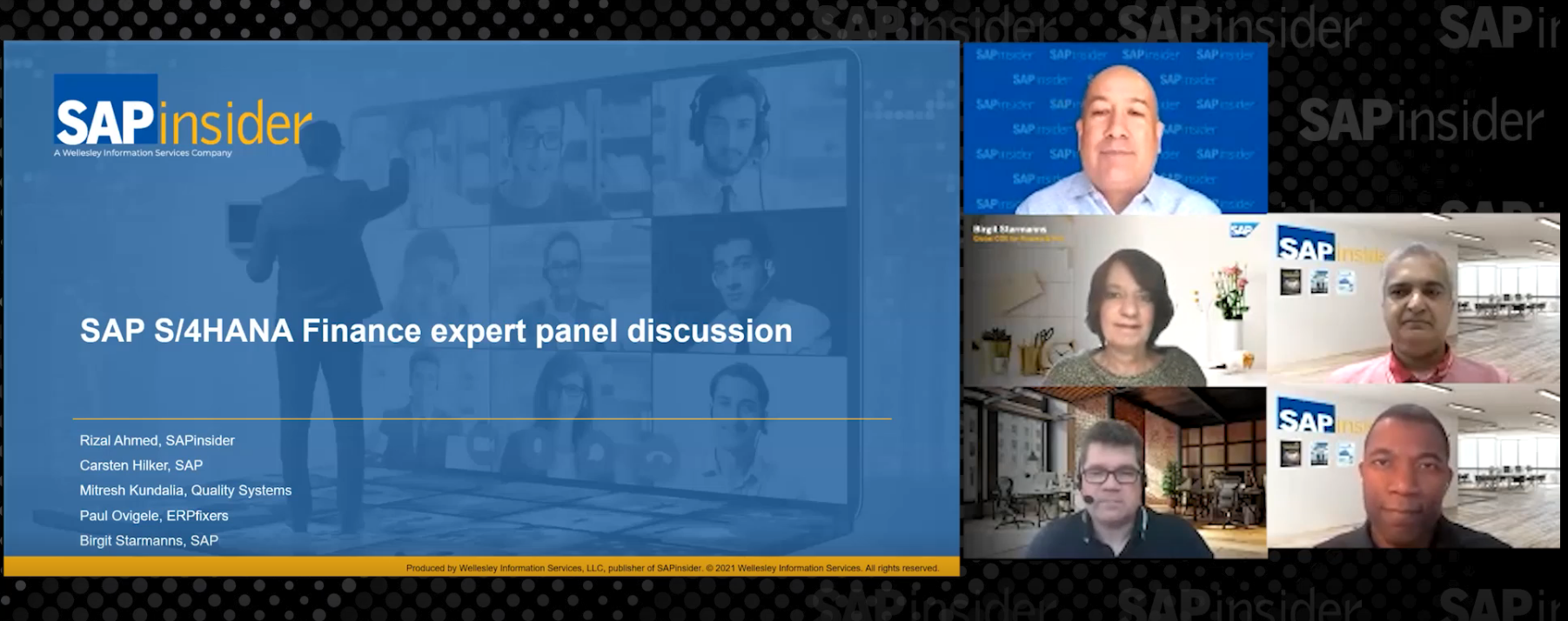What Business Users Can Expect from the New Functionality in SAP S/4HANA Finance
While SAP customers begin making the move to adopt SAP S/4HANA Finance, they often question how the new solution differs from their current SAP ECC implementation and what new capabilities it presents. Since finance is the first line of business to leverage the new innovations available with SAP S/4HANA and the SAP Leonardo portfolio of intelligent technologies, business users are eager for information on the value that SAP S/4HANA Finance can add to their organizations.
These SAP S/4HANA Finance innovations include technical and functional capabilities for both transactional and analytics processes, additional deployment mode options, and a new underlying table structure — however, the logic and workflows of the financial table process remain the same to ensure minimal disruption for business users. In addition, an updated user experience enables business users to define their own views to support forward-looking finance activities, not just backward-looking reporting, and to control what they see without the need for lengthy IT intervention.
This article will help to illuminate how these SAP S/4HANA Finance innovations provide business users more efficiency and automation, which in turn allows finance and risk teams to focus on more value-added activities. Learning objectives of the article include:
- Introducing the scope of the SAP S/4HANA portfolio across core finance and risk processes, as well as SAP’s vision for finance transformation through automation
- Reviewing the available deployment mode options for SAP S/4HANA Finance
- Exploring the innovations within SAP S/4HANA Finance, how the functional capabilities and underlying technical enhancements differ from SAP ECC, and how they support both transactional efficiencies as well as analytical processes
- Determining the key decision points to consider when moving to SAP S/4HANA Finance
To begin, let’s start with an introduction to SAP S/4HANA Finance.
The Overall Scope and Vision for SAP S/4HANA Finance
What is SAP S/4HANA Finance? Simply put, it is the entire finance and risk portfolio that is available on SAP S/4HANA.
Figure 1 shows the value map, which defines the scope of the portfolio across core finance and risk processes. The value map has been expanded from prior versions to embed analytics and compliance into each end-to-end process pillar.
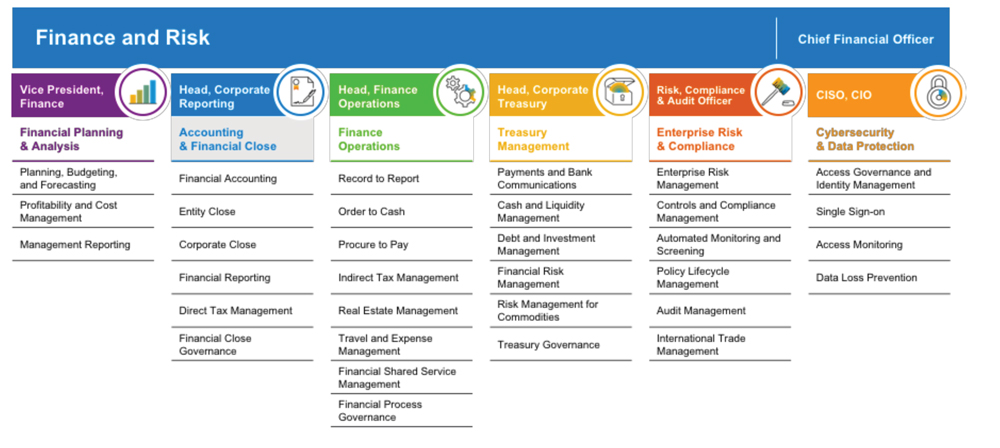
Figure 1 The value map shows the broad range of finance and risk processes encompassed by SAP S/4HANA Finance
Because finance is the core function for SAP customers that affects all other areas of the business, SAP put its attention on innovations in this space first. Finance and risk teams are the trailblazers for innovating with SAP S/4HANA and the SAP Leonardo portfolio of the intelligent enterprise, since finance was the first line of business that rearchitected the underlying financial table structures to truly leverage the power of SAP HANA. And going forward, all new functionality in finance will be built directly on SAP S/4HANA Finance to leverage the technology advances, but in general, these new capabilities will not be back-ported to SAP ECC.
The innovations of SAP S/4HANA Finance were put in place to enable SAP customers to achieve financial transformation. Figure 2 shows the vision of the journey for customers. Historically, finance and risk teams have spent the majority of their time on operational tasks — managing transactions and exceptions and concentrating primarily on backward-looking financial regulatory reporting — which left little time for insights.
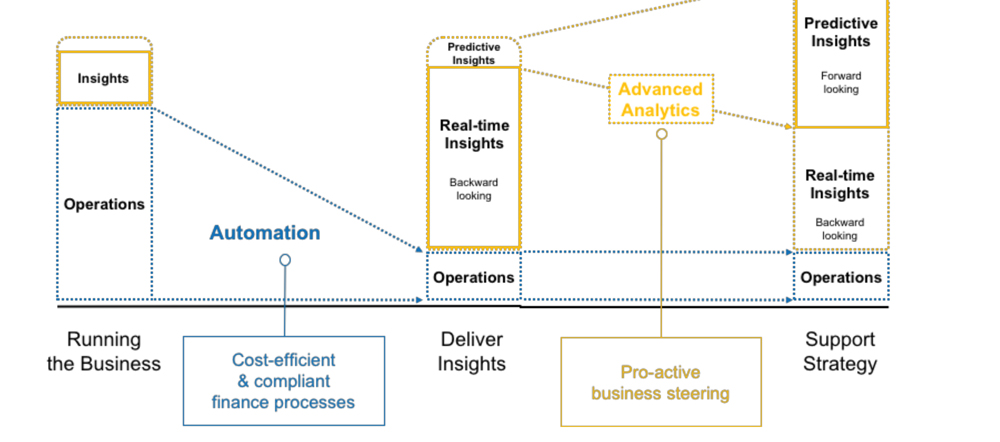
Figure 2 SAP’s vision of finance transformation leverages automation to enable finance and risk teams to provide real-time and predictive insights
However, with the advanced technology capabilities that SAP S/4HANA Finance and the SAP Leonardo portfolio provide, many of these operational tasks are automated and can be executed in real time (not only at period-end), which provides instantaneous insight throughout the period. In addition, the application of machine learning technology can then intelligently process most transactions, and finance and risk teams must only manage the true exceptions where there is no precedence on how to handle them.
Taking it one step further, machine learning also powers a predictive analytics engine — which allows finance and risk teams to model and simulate various scenarios using business value drivers to evaluate the financial impact of decisions and then advise the business on the best course of action. One example of this predictive capability is a mergers-and-acquisitions scenario, in which a company may evaluate different acquisition targets and compare those to developing a product themselves.
While it will always be necessary to keep an eye on transactions and produce reports such as financial statements for compliance and disclosure purposes, the figure shows that customers are eager to achieve an ideal state where the bulk of the insights are not only real time, but more predictive in nature, with forward-looking analysis and reporting, to allow finance and risk teams to proactively steer the business.
Next, let’s look at the variety of options that SAP customers have to deploy SAP S/4HANA Finance.
A Review of the Available Options for Deployment
In an effort to fulfill a wide variety of customer needs, SAP S/4HANA Finance is available with the following deployment modes:
- On premise. The full scope of the business suite, including lines of business and industry solutions, continues to be enhanced, and continues to be available on premise, meaning each customer installs and maintains the software and can also customize the software. New innovations are released on an annual basis.
- Single-tenant or private cloud. The private cloud offering also includes the full scope of the business suite, the difference being that the software is hosted and maintained by SAP. New innovations are released semi-annually.
- Multi-tenant or public cloud. SAP S/4HANA Cloud for finance is a new solution that refers specifically to capabilities available in the public cloud, and it is also hosted and maintained by SAP. The core financial capabilities are available, which are often used for subsidiaries, acquired companies, and small and midsize enterprise (SME) companies, but can also be leveraged by large enterprises. Configuration is possible, but no changes to the core code can be made. New innovations are released on a quarterly basis.
Customers can also run hybrid scenarios, meaning that companies that are running SAP S/4HANA Finance on premise or in a single-tenant cloud can put only selected capabilities into the multi-tenant cloud. One example is having smaller subsidiaries run on SAP S/4HANA Cloud for finance, while the remainder of the organization runs on premise. Some companies choose to run only selected scenarios in the cloud, such as supplier collaboration and invoice management with SAP Ariba solutions with an integration back into SAP S/4HANA Finance.
A more specific deployment mode for organizations that want to move only finance to SAP S/4HANA is the Central Finance deployment option (as discussed in the next section).
New Capabilities with SAP S/4HANA Finance
Let’s take a closer look at some of the innovations that have been introduced with SAP S/4HANA Finance: the Universal Journal, the Central Finance deployment option, new capabilities around the financial close process, artificial intelligence automation, apps developed on SAP Cloud Platform (often referred to as SCP), and an updated user experience. These capabilities differentiate the new solution from SAP ECC and help SAP to achieve the vision of finance transformation for its customers.
Universal Journal
The Universal Journal consolidates all financial, subledger, and controlling information into one table (ACDOCA), which then becomes one source for both transactional processes and for analytics. Separate tables for financial subledgers (such as accounts receivable and accounts payable) and controlling processes (such as cost centers and the material ledger) are no longer necessary. With the in-memory technology of SAP HANA, there is also no need for totals tables or index tables, which minimizes the reconciliation effort many companies perform at a table level and reduces the system footprint required to run finance. Plus, operational information is now included in the Universal Journal (such as customer, vendor, asset, and product codes), which enables better cross-functional reporting.
Central Finance
Central Finance is a complete SAP S/4HANA Finance system. It can be thought of as a deployment mode, in which finance information from multiple back ends — both SAP and non-SAP — are mapped into the one SAP S/4HANA Finance system, alleviating the need to upgrade each back end with its associated logistics processes. For finance, each organization can choose which processes will continue to be processed in the back-end source systems and which will be processed in the Central Finance instance. For example, one option is to leave certain financial processes in the originating back-end systems (such as accounts payable and accounts receivables) and only leverage Central Finance for corporate processes (such as consolidations, corporate financial disclosures, and management reporting across all business units). Alternately, Central Finance can be used for all finance processes.
New Financial Closing Capabilities
New capabilities for the financial close have been added to the portfolio of SAP S/4HANA Finance. For example, SAP S/4HANA for Group Reporting is the new strategic solution for consolidations across legal entities for a compliant corporate close, across multiple back ends, including SAP and non-SAP systems. This solution is available in an on-premise environment, which is also the basis for the single-tenant deployment mode and for Central Finance. A cloud-based version is also available. Financial reports are generated by leveraging the functionality of SAP Analytics Cloud. Future capabilities for disclosure management, for generating annual reports and electronic filings for statutory reporting, such as XBRL electronic filings, are planned to move from the existing solution SAP Disclosure Management to one based on SAP S/4HANA Finance.
The upcoming SAP S/4HANA for advanced financial closing solution, the next-generation replacement for the SAP Financial Closing cockpit, manages the entire end-to-end close process, including automated and scheduled processes, as well as manual processes, to provide a picture of the status of the close at any time — be it a monthly, quarterly, or year-end close. It also embeds risk and compliance processes.
As a long-standing partner, BlackLine has several products that are now offered directly through SAP as official SAP Solution Extensions. These solutions are delivered in the cloud and can be run against both on-premise and cloud deployments of SAP S/4HANA Finance. SAP Account Reconciliation and Automation by BlackLine reduces the risks and manual efforts associated with the financial close. The solution helps finance teams focus on account substantiation and documentation to provide enhanced audit trails, especially where information is coming from external sources or from manual entries. SAP Intercompany Financial Hub by BlackLine provides this substantiation for financial entries that have been made across legal entities, and highlights differences in situations such as manual errors, the timing of elimination entries, and exchange rate differences.
Automation via Artificial Intelligence and Machine Learning
In the past, companies have relied on rules engines to load information about clearly defined processes; in SAP ECC, this primarily meant using configuration tables to define rules such as payment terms for customers and vendors. When it comes to artificial intelligence available with SAP S/4HANA Finance leveraging the SAP Leonardo portfolio, there are two primary types of automation: robotics process automation (RPA) and machine learning. RPA helps to run repetitive tasks that are based on rules, which is similar to running a macro that executes rules and formulas on different spreadsheets with the same format, but different data.
The real power of artificial intelligence is in machine learning, which is being directly embedded into processes. Machine learning technology uses knowledge it has gained through a training process using prior transactions, as well as learning from how finance and risk teams handle transactions when exceptions occur, to make recommendations — and post, if desired — on how to handle exceptions for processes such as cash application and goods receipt/ invoice receipt reconciliation. In addition, machine learning technology in SAP S/4HANA Finance powers predictive capabilities — such as to forecast a company’s liquidity or to identify patterns to uncover fraud.
SAP Cloud Platform Applications
Applications developed on SAP Cloud Platform allow organizations to extend the capabilities of their existing implementations, without the need to change their core systems. These apps are delivered in a multi-tenant cloud, but they can run against all deployments of SAP S/4HANA Finance including on-premise, single-tenant cloud, or multi-tenant cloud, as well as Central Finance. Each SAP Cloud Platform app is very specific to a particular function, whether that function is transactional (such as cash application for receivables or for processing digital payments) or analytical (such as financial statement insights or for an analysis and prediction of cost-center spend).
Updated User Experience
Business users can access the transactions available in the Universal Journal directly, in real time, through SAP Fiori-based dashboards. Summary information, such as account balances for financial statements and profit and cost center balances, is available instantaneously. Key performance indicators (KPIs) can be calculated, such as operating margins and DSO (days sales outstanding). Also, trends such as outstanding receivables over time are illustrated, as well as the results of simulations and predictive capabilities such as cash and liquidity projections. Individual business users can configure the parameters of these KPIs — for example, adjusting the tolerance of receivables outstanding. These dashboards also facilitate drill down into the granular details if the KPIs indicate an issue, and business users can configure the fields that they need, without requiring IT intervention. Figure 3 shows an example of such a dashboard.
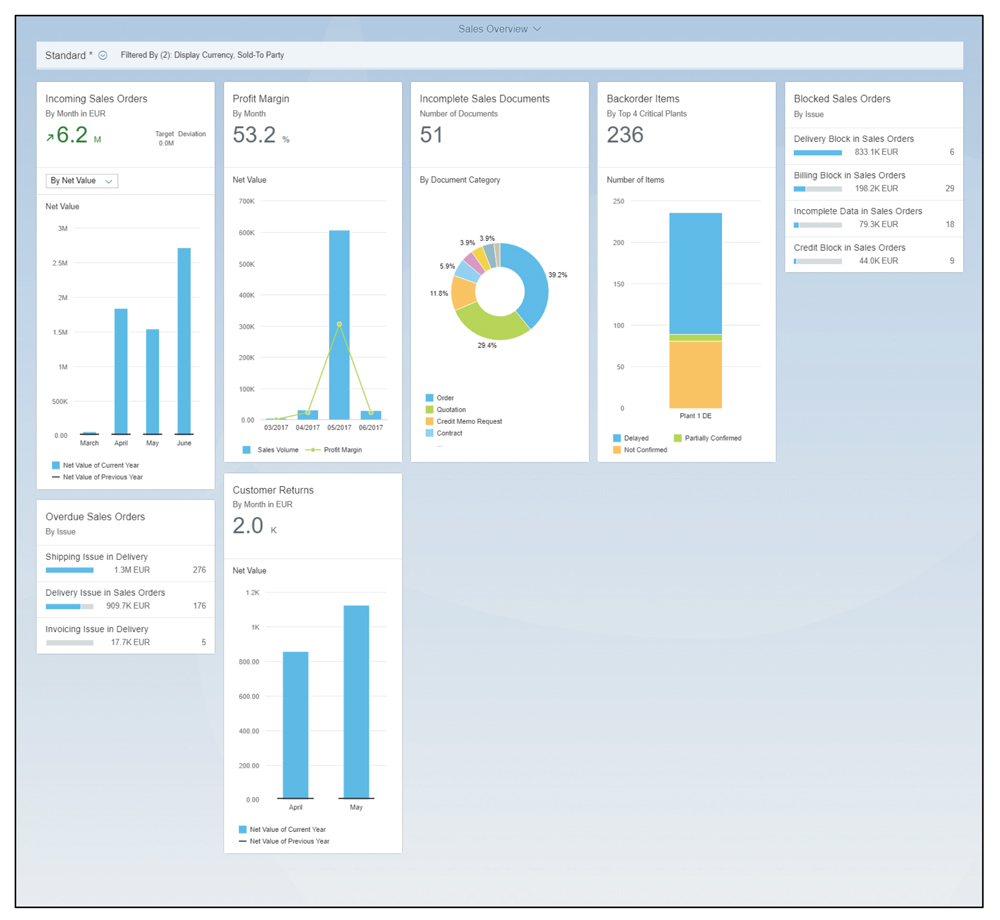
Figure 3 An SAP Fiori-based dashboard of an overview page that is relevant to a sales controller
Now that we have reviewed the new capabilities and functionality available with SAP S/4HANA Finance, let’s look at the key decision points that SAP customers consider as they prepare for a deployment of SAP S/4HANA Finance.
Key Decisions When Moving to SAP S/4HANA Finance
There are multiple options in moving ahead with an implementation of — or a migration to — SAP S/4HANA Finance. Depending on your current environment, these decision points vary. However, generally, SAP customers need to keep the following decision points in mind:
- What processes will be included in the scope of the SAP S/4HANA project?
- What deployment mode should be selected?
- Should the implementation be greenfield or brownfield?
- What online tools can help in evaluating the best approach?
Next, let’s look at each decision point in turn.
What Should the Scope Include?
Finance is increasingly at the forefront of leveraging the latest technologies. Many organizations choose to use a finance-first approach, meaning that finance processes are moved into the SAP S/4HANA environment, leaving in place existing back-end processes that still contain operational and industry-specific processes.
Alternately, an organization may choose an all-encompassing SAP S/4HANA implementation, which involves all processes, such as finance, logistics, and any industry-specific capabilities based on business requirements that include — but extend beyond — finance. These projects tend to run longer due to the larger scope.
Which Deployment Mode Is the Best Fit?
A key decision point here is whether to choose an on-premise implementation, a single tenant (private) cloud, or a multi-tenant (public) cloud deployment, as discussed previously in the section “A Review of the Available Options for Deployment.” Customers can also choose a hybrid approach, placing only selected processes into the cloud. Practically, if an organization chooses a finance-first approach for its scope, the deployment mode very often points toward the Central Finance option.
Is Greenfield or Brownfield the Right Approach?
A greenfield implementation means that an organization may choose to start “from scratch,” even if there are existing SAP ECC systems in place. This option is most often chosen by customers who have been live for an extended period and would like to see changes in how their organizational structure is reflected in the system. This approach also enables them to more easily leverage new capabilities as well as update their existing configuration — especially where there have been significant organizational, economic, and market changes since their original implementation.
A brownfield implementation approach means that customers choose to upgrade their current environment. This approach is most often taken by customers who have more recently undergone SAP ECC implementations — where they are still satisfied with their current configuration and how their organizational structure is reflected in their current implementation.
What Online Tools Are Available to Help?
In addition to taking a close look at their internal processes, SAP customers should also investigate the available resources online when evaluating their approach to these key decisions and building a business case for SAP S/4HANA Finance. SAP offers several tools that can help. The SAP Value Advisor shows the KPI results that have been achieved by other customers in their move to SAP S/4HANA Finance. The SAP Transformation Navigator uses customers’ existing landscape to see which products have been implemented and to define a future product map leveraging the SAP S/4HANA Finance portfolio, and it allows customers to define their own value drivers to receive realistic improvement ranges plus an initial project work breakdown structure to use as a starting point. The Digital Finance Readiness Assessment provides a customized survey of 15 questions across four sections, which delivers a customized report of where an organization stands in terms of readiness for a digital transformation.
Summary
As highlighted in this article, there are significant changes in capabilities and technologies to consider when moving to SAP S/4HANA Finance. A key point to keep in mind is that most of the new capabilities now available with SAP S/4HANA Finance cannot be back-ported to SAP ECC, because these innovations leverage the new in-memory technology of SAP HANA as well as the SAP Leonardo portfolio.
Another key point is that projects involving a move from SAP ECC to SAP S/4HANA Finance will require change management — from communicating project objectives and expected results to training finance and risk team members so they fully understand the changes and can participate in the finance transformation process. Ultimately, such a move can have a significant positive impact on the value that finance and risk teams can provide to their organizations.
For information about SAP S/4HANA Finance, including customer stories, please visit www.sap.com/finance.

